‘The one thing that I don’t feel is loss,’ says widow
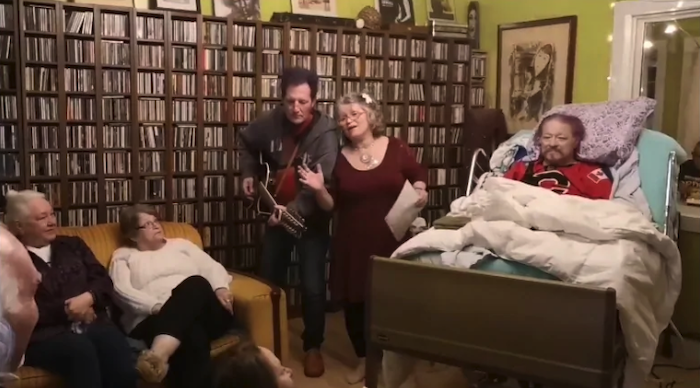
By Dominika Lirette
When Dan Laramie died, he went out on his own terms — with music, whiskey and cigars.
“He really wanted a party,” said Stef Laramie, Dan’s widow. “He really wanted a celebration and I loved that idea. It just made it so great.”
The 68-year-old South Okanagan man had a medically-assisted death last Saturday at a close friend’s home in Keremeos, while surrounded by 50 friends and family.
“We had to make sure that we got it out there, that people really understood that at this celebration it would be his last heartbeat and that he would be assisted in dying,” said Laramie.
‘Way too much’
About two months ago, Dan Laramie decided he wanted to have a medically-assisted death, Stef Laramie told Daybreak South‘s Brady Strachan.
Dan Laramie had diabetes since childhood, but the disease had grown worse and he was having problems with his blood pressure, kidneys and heart.
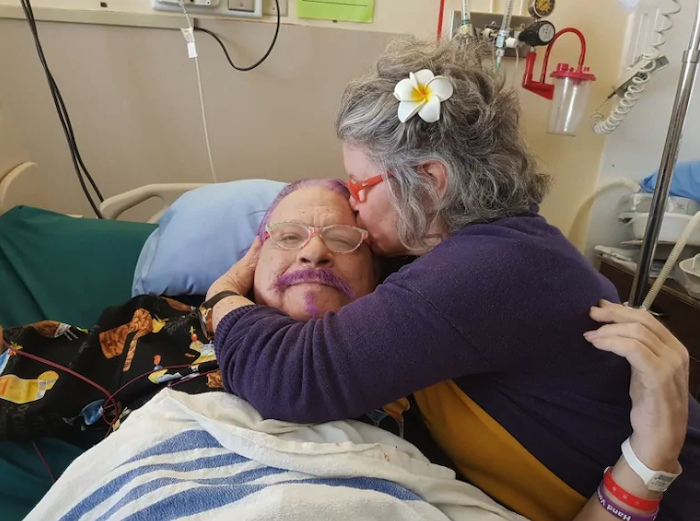
Last May, a surgeon told Laramie at an appointment that he’d have to amputate a couple of toes and he was immediately hospitalized. Laramie had an aggressive form of gangrene, which later led to other amputations including half of his foot and part of his leg.
“It got to be way too much. Right from the beginning he always said ‘I just don’t want them nipping away at pieces of me to try and save me if I can’t be saved’,” Stef Laramie said.
Dan Laramie’s condition continued to deteriorate at a rapid pace. There was calcification in his blood vessels, his organs were failing, and they realized his body was no longer able to heal at the rate it needed to for him to live.
Musician
Dan Laramie was a musician, so it was important to him that the final gathering with friends and family had lots of music.
Stef Laramie, who is a singer, said she and her husband once had a Karaoke band called K-town and a five-piece rock band called Lulu and The Lazy Boys.
“Dan was just an amazing guitar player. He could play rhythms, and leads, and bass, and all kinds of things all at once,” said Laramie. “When he was in the hospital he wrote 30 songs.”
One of the songs he wrote was about the nurses who cared for him, and they sang it at his party.
‘Just magical’
Dan Laramie’s friends, sister, son, daughter, grand kids and even some of his nurses all came to the party.
There was food, and single malt whiskey and cigars that an old friend brought for Dan.
“It was just magical how everybody looked after each other. People would burst into tears sometimes and somebody would just be kind and give them a hug,” said Stef Laramie
Stairway to Heaven
Towards the end of the night, Dan Laramie’s doctor and a nurse arrived to assist with his death.
“You could see sort of an energy in the room where people could feel that it was time,” said Stef Laramie.
Once Dan Laramie signed the papers and said he was ready, his family gathered at his bedside.

“I can’t even tell you how beautiful the look, the smile was in his eyes,” she said.
As requested, his friend, Michael Fitzgerald, played Stairway to Heaven, as the first needle was administered.
“Dan wanted applause…so oh my gosh did we ever clap and cheer,” said Stef Laramie.
“He was so ready and it felt like everything that we talked about… all these people coming, made it the absolutely perfect exit.”
Not sorrowful
“The one thing that I don’t feel is loss,” she said. “If he had died in a way that we had no notion of it, by surprise…then it would be sorrowful. But I don’t think dying should be sorrowful.”
After this experience, Stef Laramie said she learned that if you have a great life, death doesn’t mean as much.
“You don’t have to let anybody start dying before they have left.”
Complete Article ↪HERE↩!
Music therapy ministers to patient needs in ‘winter of life’
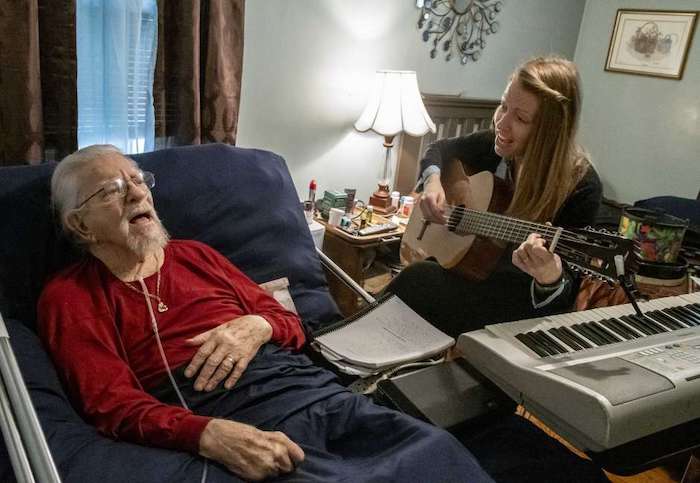
By MICHELE VOWELL
“At 92 years old, I finally learned to do as I’m told,
The sun comes up, the sun goes down,
The earth keeps goin’ ’round and ’round.
I’m content where I am.
In the winter of life, I do the best that I can.”
Princeton resident Donald Granstaff spends much of his time these days looking back on his life.
The 92-year-old husband, father, Navy veteran, musician, preacher and missionary served his country and God for decades around the globe. Today, Donald often reflects on those times from his bedroom while under the care of Pennyroyal Hospice.
“I was thinking the last few days, what have I accomplished?” he said Monday afternoon. “Around the world twice. Haiti and the West Indies — all that. And all I can come up with is the guys that I prayed with and I lead them to the Lord. And, I suppose that’s what it’s all about.”
To help Donald face the winter of his life, Kenna Hudgins, board certified music therapist, brings her keyboard, drums, guitar and even a tambourine, weekly to share an hour of tunes with the elderly patient at his home. Hudgins and Donald sing familiar songs and play the instruments together in an effort to make his transition easier.
“The main goal I initially assessed (for Donald) was for anticipatory grief — to work through the acceptance of the fact that we are terminal and now on hospice (care),” she said. “He’s very aware, so day after day just knowing that it’s coming and there will be changes and decline. Life is hard. Music therapy offers a way to process that musically.”
Music therapy
“Anyone who responds to music can benefit from music therapy, especially in hospice,” Hudgins said. “Music plays a role in all of our lives. It always has. It’s why we can watch a movie and feel scared, feel love or feel emotion. Music causes neurologic response — it affects our whole brain — in multiple areas simultaneously. Because of that, music therapy is not about being a musician. It’s not about understanding music. It’s about just responding.”
Hudgins, who is a contractor with Pennyroyal Hospice, uses her skills as a board certified music therapist to address the needs of patients in Christian, Todd, Trigg, Lyon and Caldwell counties in western Kentucky.
“Hospice is very grounding,” Hudgins said. “Every day that you go into somebody’s house and they’re dealing with their struggles, it brings you back to true purposes — day-to-day tasks and stresses don’t matter as much because life is short. Personally, it’s just a very rewarding field.”
Communicating with hospice social workers, Hudgins identifies patients who may benefit from music therapy. She asks family members for 10 minutes of their time to visit their loved one and share a song or two with them to assess his or her responses.
“I don’t usually talk much about it, I just let them experience it,” she said, smiling. “I’ve never been told not to come back and it’s never just 10 minutes.”
Hudgins said everyone has memories associated with certain music.
“A therapist’s job is to find that music that is significant to that person,” she said.
Working with some patients can be difficult, Hudgins said, because of the emotions tied to facing the end of life, but sharing music with them is rewarding.
“Music is so joyful,” she said. “When I get to bring joy to a family and a loved one … that’s not a sad job. … I’m really blessed to just be a part of their lives. To bring joy is just huge.”
Music with Donald
After working with Donald for several weeks, Hudgins said her therapy goals for him shifted to decreasing his feelings of isolation.
“I try to get as much participation from him physically, whether that’s playing the keyboard or drumming,” she said. “As his hands might get more stiff, clapping — anything to get his body engaged. If his body is unable, then just getting him to verbally participate. That, in and of itself, will decrease isolation.”
In Monday’s music therapy session, Hudgins wanted Donald to sing some love songs with her while playing instruments.
“With Valentine’s day coming up next week, we’re going to do sweetheart songs,” she said.
“The old sweetheart songs,” Donald said. “That’s the best kind, the old ones.”
The duo harmonized to Bing Crosby’s “Let Me Call You Sweetheart” as Hudgins played the keyboard.
“Let me call you sweetheart
I’m in love with you
Let me hear you whisper
That you love me too …”
In the middle of the song, Don stopped singing to share a childhood memory.
“I used to hear my dad sing that one all the time,” Donald said.
“Yeah? Did he sing it to your mom?” Hudgins said.
“Yeah. He worked in vaudeville for a long time,” he said. “He played mandolin and violin, and he sang all the time. He loved to sing.”
“Good memories,” Hudgins said.
Donald married his own sweetheart Betty 68 years ago. They exchanged vows on June 16, 1950.
“It was my birthday,” he said.
In the living room, Betty sat on the couch quietly listening to her husband sing and play music with Hudgins. She said music therapy is a comfort to her and Donald, who played several instruments, including the organ, keyboard and drums since he was a boy.
“I love that he’s even trying,” she said after the session. “I think this is a good thing for him because he was a musician. It meant so much to his heart. That was his life.”
Back in his bedroom, a second song, Frank Sinatra’s “My Funny Valentine,” also sparked Donald’s memories of his father.
“That’s a good song,” he said. “He used to sing songs like it.”
“I’m glad I’m making you think about your dad. I haven’t heard you talk a lot about him,” Hudgins said.
“He was quite a man. Yeah boy! He was something else,” Donald said, remembering times they would go fishing together at Lake Barkley. “He owned a couple of boats. Nice, big boats. And I used to go with him on the boats.”
Midway through the hour, Hudgins sang the chorus to a song about Donald’s life they wrote together after three or four music therapy sessions.
“I am a husband, a father, a preacher, a teacher
A born-again, saved-by-grace man …”
“When I came out of college, I was a really smooth character,” Donald said, listening to the lyrics. “I was fast and furious, and I didn’t stay that way very long. I was saved in June 1959, and before that I was a ‘religious’ human being …”
Early in their marriage, Donald and Betty took their five children to the mission field in the British Isles of the Caribbean and later in Haiti. Donald also helped another missionary build a radio station in Dominica. When they moved back to the U.S., he pastored a few churches in McMinnville, Tennessee, and Princeton. For a time, he often played the organ in the Barkley Lodge dining room.
“He was a musician from the time he was little,” Betty said. “Every church we were a part of he would play the organ until he wasn’t able to physically.”
Now, Betty said, some days can be difficult.
“Sometimes I have an overwhelming sadness. It’s hard to see him not be able to do anything,” Betty said, crying. “God love him, he never complains. Never, ever complains about anything. He’s just always up and very sweet. He’s still a testimony to everybody that visits him because of his attitude.”
Happy Trails
To close out Monday’s music therapy session, Donald and Hudgins sang the Roy Rogers and Dale Evans classic, “Happy Trails.”
“Who cares about the clouds when we’re together?
Just sing a song, and bring the sunny weather.
Happy trails to you,
Until we meet again.”
“I think it’s good. It can help lift you up,” Donald said of music therapy with Hudgins. “I’m not like some guys. Some guys get tired of it, throw their hands up and leave. I’ll try.”
Hudgins said Donald “still has a lot of life in him.”
“Whether (the patient) is a musician or not, music is a way to connect with the outside world. It can pull you into different areas of your own life, make you feel alive again,” she said.
Part of Donald’s legacy will be the song he and Hudgins wrote together.
“We have created a tangible song that he can leave for his family,” she said. “His family are musicians so they can actually play that song and play it with him.”
The chorus is:
“I am a husband, a father, a teacher, a preacher
A born-again, saved-by-grace man.
I’m a musician, woodworker, a servant, missionary
But most of all I’m just a good ole boy from Kentucky.”
Donald and Hudgins plan to meet next week for music therapy.
“Every one of us has had music in our lives that has impacted us,” Hudgins said. “It’s my job to figure out what is going to impact someone at the end of their life for the best end-of-life experience possible.”
Complete Article ↪HERE↩!
Facing the end with a friend:
The misperceptions and realities of hospice care
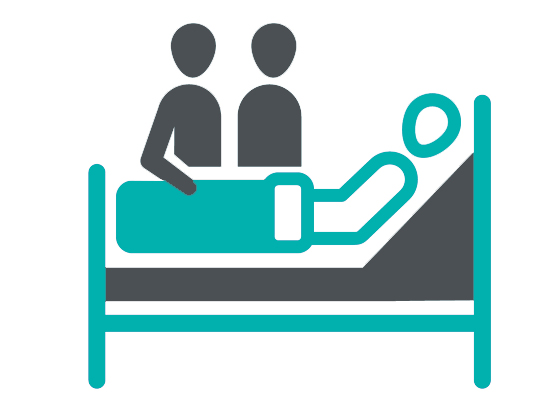
People who work in hospice care are often asked how they can work in a setting where most of the people around them are facing the end of their life — isn’t it “depressing”?
Put simply, hospice is end-of-life care that is both clinical and emotional in nature. It is designed to relieve suffering for the patient and his or her family during the last days of life — typically the final six months to a year. It is initiated only when curative treatments are no longer an option. Hospice workers and volunteers help their patients live their last days in peace and comfort, receiving care that meets their wishes.
For those with limited time remaining, hospice care enables them to focus on enjoying their friends and family during their final days. This is made possible with integrated clinical, emotional and spiritual support from a team of professionals. They include physicians to manage symptoms and pain; nurses who meet with patients and their families to gain a better understanding of their ongoing needs; and certified nursing assistants, including home health aides who provide hands-on care and support, as well as help with the activities associated with daily life.
Volunteer perspectives
Deana Ozuna is a hospice volunteer for Southwest Medical Hospice. She had worked for 13 years in various administrative departments in health care locally and began volunteering in hospice care in 2006. She has encountered the “isn’t it depressing?” question before, and her answer is a resounding “no.”
“I accept things as they are,” she said. “Everyone wants to be cared for. They want to be acknowledged. Connecting with people and seeing smiles on their faces just make me feel so good.”
George Pratt is also a hospice volunteer for Southwest Medical Hospice and has done so along with his wife Patricia since 2008.
“Sometimes I would agree, it can be sad, but I look at it this way — if I have reached the last chapter of my life, I’d like someone there with me. The family also needs relief from the stress and strain of the situation. The end is inevitable, whether you are there or not. Being with them at the end to give them a ray of sunshine is a good thing.”
April Stewart is the chief nursing officer for Nathan Adelson Hospice. She’s been working in hospice for 12 years. “Hospice is who I am,” she said.
Ozuna said that attitude is everything. She said one key is “the ability to be upbeat and smile when you walk into the room. They love it because they so often are around people acting somber and restrained. When I first started doing volunteer work, people were thrilled to see a smile, and they want to talk and learn about me. They are happy to have company.”
Pratt agrees, adding that “you need to be comfortable simply sitting and conversing with people. You need caring and patience.” Pratt said that he often revisits various chapters of his own life and speaks with patients on a wide range of topics. “It’s a matter of being able to listen, to show that you care.”
The job isn’t as depressing as people might think, said Stewart. “This is the most rewarding job I have ever had,” she said. “Hospice patients have the most beautiful stories to share. How lucky are we to be a part of someone’s life at this point in their journey? If we as a team can come together and provide true hospice care in the way it was intended, it is an amazing journey for all involved and can make a very sad, emotional time a little less scary.
Discovering a niche
After working in numerous hospitals and intensive care units, Dr. Dean Tsai, a medical director of hospice and palliative medicine for SMH, felt that medical care was often delivered without asking what the patient’s goals were, especially as patients got sicker and the treatments got more difficult. After helping a patient in respiratory failure to be comfortable as he was compassionately extubated, he sought out more experience in hospice care, leading to working full-time in the field in 2007 and transitioning to his job as medical director in 2008.
“It’s actually the most rewarding job I’ve ever had,” Tsai said. “We get heartfelt gratitude from families every day. Yes, it can be sad, at times, but it’s not depressing and almost always rewarding. I get to listen to patients tell their stories and often talk about what is most important in life.”
Tsai notes that the hospice setting and facing your own mortality can actually be a gift of sorts.
“Much of the time, despite the despair of dying, if one is given the fact that their time is very limited, it allows them to say their goodbyes, prepare their legacy, make amends or speak to loved ones,” he said. “This is considered the gift of hospice.”
For Dr. Lisa Rosenberg, also a medical director of hospice and palliative medicine for SMH, her first hospice experience was volunteering while a medical student. While she originally had planned to be a neonatologist, she realized her calling was for older adults. She later worked 15 years as a geriatrician, spending time with patients near the end of their lives. End of life care was always part of her work. She considers her move to hospice as the best professional decision she’s ever made.
Rosenberg has witnessed that some patients and their families can be good at emphasizing the positive or the negative, depending on their personality.
“Part of it is who we are, the other part is acceptance of the situation and accepting assistance,” Rosenberg said. “Sometimes it is a sorting through of one’s life or relationships. When someone recognizes that their time is limited, it can actually be a gift. We have resources to help with that.”
Stewart received a bit of on-the-job training when beginning her hospice career.
“These skills develop over time. The wife of my first hospice patient in 2007 told me, ‘We like you and we want you to be our nurse.’ I shared with them that I was still new to hospice so I would be in a supportive role,” Stewart said. “She then said to me, ‘If you come and care for my husband, I will show you how to be a hospice nurse.’ It turns out that she had been a hospice nurse for many years before she retired. I learned a tremendous amount from the two of them. Mainly — go into each situation with an open mind and open heart, determine what is needed of you, and make sure it happens. People don’t always need medical intervention. More often than not — they need your hand or your shoulder. Be present.”
Other misperceptions
Tsai and Rosenberg have encountered other misperceptions beyond the “depressing” question, like where the care takes place.
“Hospice is a service, not a place,” said Tsai.
While hospice care can take place in a clinical setting, a lot of hospice care takes place in the home.
“When people are enrolled in hospice, you don’t have to ‘go anywhere,’ and you aren’t necessarily bed-bound,” Rosenberg said. “The vast majority are cared for by family members at home with all the needed medications, equipment and support from our team. We continue to manage disease and symptoms. If a new symptom emerges, and a new medication is needed, we can have it in the home in less than two hours. We deliver great care and when things need to happen quickly, they happen very quickly.”
Stewart said that there is often confusion about medications in hospice.
“Some people still think that hospice just medicates people with morphine to the point that they can no longer be alert and starves them,” she said. “It is so sad and creates a lot of barriers in care. The truth is the patient is the one in charge of their care — that’s what hospice is all about.”
Rosenberg said that hospice care can take various forms. It’s about meeting the needs of patients and their families wherever they are at that point in their journey.
“If someone has stage-4 cancer and says they want to go on a cruise or go to a friend’s wedding, we can help them with these goals,” Rosenberg said. “If someone is electing to pass peacefully at home surrounded by loved ones — which is how death has happened in most of mankind’s recent history — rather than a hospital room, we support that.”
When the end comes
One particular memory has remained with Stewart.
“I once had a patient who was married to his wife for 50-plus years. When he began to transition to his final journey he said to me, ‘Please promise me one thing. I want my beautiful wife to be the last thing I see.’ I promised him I would do my best to make sure that happens. I was providing continuous bedside care.
“The time came for his wife to turn in for the night. He started to exhibit signs that he may pass. I went and got his wife and told him she was there with him. I sat him up and he was able to open his eyes as he took his last breath while holding her hands.
“It was the most beautiful expression of love I have ever seen.”
Pratt said that thinking of the good times is a good approach.
“Whenever I am with a patient, we don’t talk about the end. We talk about the journey — grandkids at the holidays, gratitude for having grandkids,” Pratt said. “One of the military service members I’ve worked with, he’s thankful he came home from the war, thankful that he married, thankful he raised a family, thankful that he traveled with his wife. You focus on the accomplishments and not the end.”
If others are encountering a similar struggle with a friend or family member with a terminal illness, he encourages them to just not give up.
“Treat them no differently than you would a friend. I’ve seen families that came together, some that pulled apart,” Pratt said. “When the whole family pulls together, that is best. It’s a team effort.”
Rosenberg said she has had hard days in her work, but most days are very good. One recurring difficulty she has witnessed is when a patient said they are tired of fighting, and a well-meaning family member said, “you have to fight.”
“That is very hard,” the doctor said. “It’s important to listen to patients, to hear their wishes for this stage of their life and to be respectful of them.”
Rosenberg sees hospice care as a return to a more natural state of care, pointing out that 150 years ago, people typically died at home surrounded by family and friends. It’s often now turned into a medical event.
“Mostly, I think what we do is beautiful. We don’t put patients on the path to dying. They let us come in and support them. We’re all in the same place working to relieve suffering and maximize joy and meaning.”
Complete Article ↪HERE↩!
Would you help your good friend die?
“Paddleton” is a road movie with a heavy destination
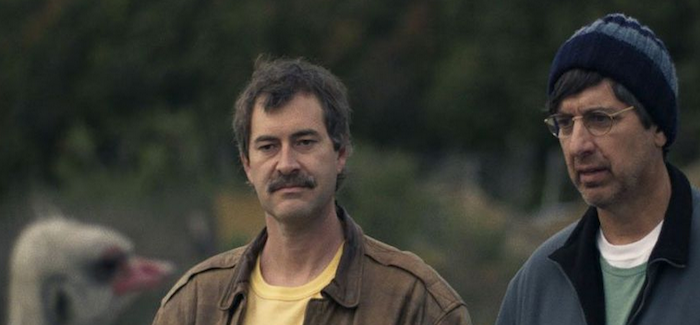
I don’t know what your definition of a true friend is, but mine would definitely include “willing to help me die.”
The Netflix feature “Paddleton” is a laconic road movie about the relationship between the terminally ill Michael (Mark Duplass) and Andy (a restrained, terrific Ray Romano), his upstairs neighbor and best friend. Not much happens. Except life and death. Michael has the good fortune to have metastatic cancer in California, which means he can exercise the state’s right to die option. “I don’t want to do it alone, and I was hoping,” he tells Andy as they casually nibble cashews one afternoon. “You would help me out.”
The concept of how to have a decent death has provided plenty of fictional inspiration over the years. Sixteen years ago, Ryan Murphy’s “Nip/Tuck” did a haunting arc about a woman with late stage breast cancer enlisting her lover, a doctor, to assist her in making a peaceful exit. The Oscar-winning 2012 “Amour” similarly explored assisted death as an act of love. And just two years ago, “Grace and Frankie” introduced Babe, a free-spirited pal of the girls who asks for help planning a blow-out farewell party — and a glitch-free ending for her life. Estelle Parsons was lauded for her guest role, but not everyone was a fan. One ethics blog subtly described the episode as “Grace and Frankie kill their friend.”
California’s End of Life Option Act came about in no small part thanks to the legacy of Brittany Maynard, a 29 year-old Anaheim woman who spent her final months advocating to die with as much agency as possible before her brain cancer took over. She died in Oregon in 2015, surrounded by family and loved ones but far from home, because she needed to be in a state that would provide the appropriate environment. Physician assisted death is currently legal in seven states and the District of Columbia, though it continues to face numerous legal challenges.
But “Paddleton” isn’t a right to die movie. There is no courtroom battle to be fought, nor any secretive pact to be made. When Andy initially goes through the routine dance of assuring Michael that he can’t give up because “miracles happen,” Michael counters, “They already gave me the prescription.” Andy grapples with his assigned role a moment, then stoically tells him, “OK.”
The men take a leisurely six-hour drive to one of the few pharmacies in the state that will fill the prescription. They bicker and drink and have loose, random and often very funny conversations. They return home and face the increasingly imminent fact that one of them will not be there much longer.
“Paddleton” (named for one of the men’s made-up games) was co-written and co-stars Mark Duplass, so it comes as no surprise it has a certain mumblecore je ne sais quoi. Scenes stretch out almost aimlessly. The repetitive routines of two schlubby, not very dynamic individuals play out in real time. There are no noble speeches. Yet within the film is a resonant meditation on the uniquely bewildering experience of imminent grief. “I’m the dying guy!” Michael yells to Andy at one point late in the story. “I’m the other guy!” Andy retorts, helplessly, heartbroken.
I’ve spent a lot of time the last several years being the other guy. I’ve sat with friends shriveling in their hospital beds. I’ve attended family funerals other relatives wouldn’t. I watched “Paddleton” a few hours before learning of the sudden death of one of my daughter’s oldest friends. And all I’ve ever really learned from all of it is that whether you’re prepared for it or not, the loss of someone you love will hit you like a baseball bat, and keep hitting you for longer than you ever thought possible.
The men in “Paddleton” are overgrown kids who like puzzles and pizza. Yet there are few tasks in life that demand as much delicacy and grit as facing death, and that task they manage with exemplary skill. As they sit together on Michael’s floor, preparing a final cocktail, Andy deadpans, “I don’t even know if you had to buy this particular pill. A hundred of anything would . . . you know.” He is sincere and reassuring and not somber. And when he later goes alone into the kitchen to mix the drink, Andy adeptly performs the chore, pausing only briefly to rip off a paper towel to dab his eyes.
I aspire to die someday with dignity, though I’m not currently making a fantastic show of living with it. Neither are any of the characters of “Paddleton.” They are — even the peripheral ones — awkward and strange and pretty weird. Maybe most of us are. And as much as we deserve a death with dignity, we long for one with empathy, shared with a friend who’ll hold our hand as we leave, and miss us when we’re gone.
Complete Article ↪HERE↩!
Shaina Garfield redesigns death with eco-friendly macramé coffin
LEAVES from Shaina Garfield on Vimeo.
By kieron marchese
soon after shaina garfield realised her vision for an eco-friendly coffin, she noticed that what she had actually made was a coffin for herself. after being diagnosed with chronic lyme disease four years ago, the prospect of death caused a preoccupation that would eventually inspire her work as an industrial designer. as she tackled the prospect of dying, she discovered an interesting contradiction between something that essentially brings people closer to earth, and the harmful impact death practices have on the planet. after a closer look, traditional burials, embalming and cremation, all involved the pollution of nasty chemicals and toxins.
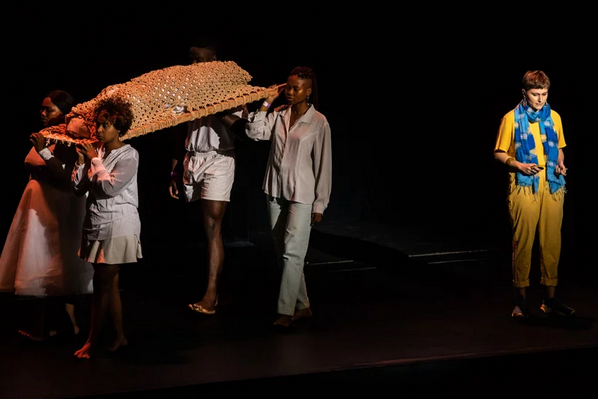
speaking at design indaba 2019 shaina notes that we’ve become so far removed from nature as a result of human exceptionalism – the belief that humans are the most important entities in the universe. so she came up with ‘LEAVES’, a textile coffin built from sustainable materials, that hopes to bring us closer to the planet that we live on.

composed of a netting that wraps around the deceased, LEAVES works to make the burial process a much greener ritual. the design uses rope which has been treated with a dye and embedded with spores, encouraging fungus growth that speeds up decomposition and eats any toxins in the body. a tree is then planted on the burial site, making the most of this nutrient rich soil. instead of cemeteries, shaina imagines luscious areas where nature is representative of the greater purpose our bodies can have.
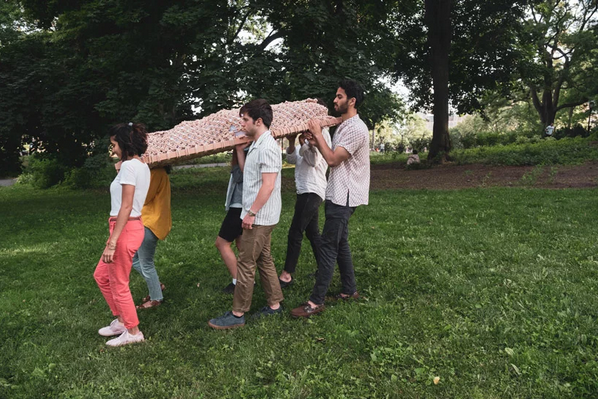
as much as it lessons the impact humans make on the planet, LEAVES also promotes positive discussions around death. drawing from funeral practices around the world, shaina considered ways in which her designs could help to support people with their grief. she imagines those mourning the death of someone coming together to tie the knots necessary to make the coffin, a meditative experience that intends to help with emotional healing.
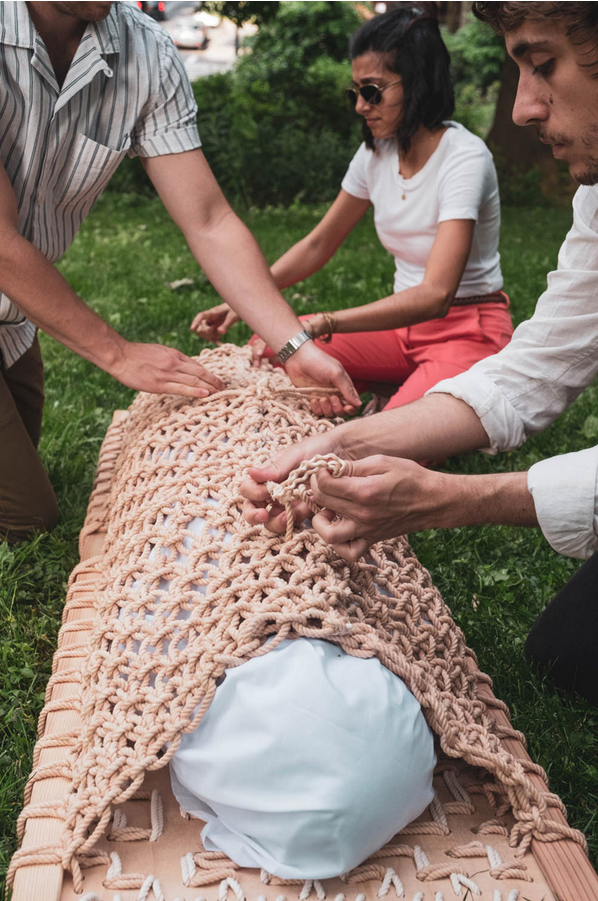
shaina describes herself as an ‘advocate celebrating people and the earth‘, and it’s this relationship that forms the basis of her work. in a powerful description she exposes the reality that at death we are actively disconnected from nature. we choose at all costs to ‘keep ourselves in a domestic dream‘ and in the process, our consideration for the planet is nil. the natural resources it takes to make coffins, the toxins that are emitted into the air during cremation, and the chemicals seeping out of graveyards because of embalming, are all cause to believe that our attitudes towards death and the planet we live on are wrong.

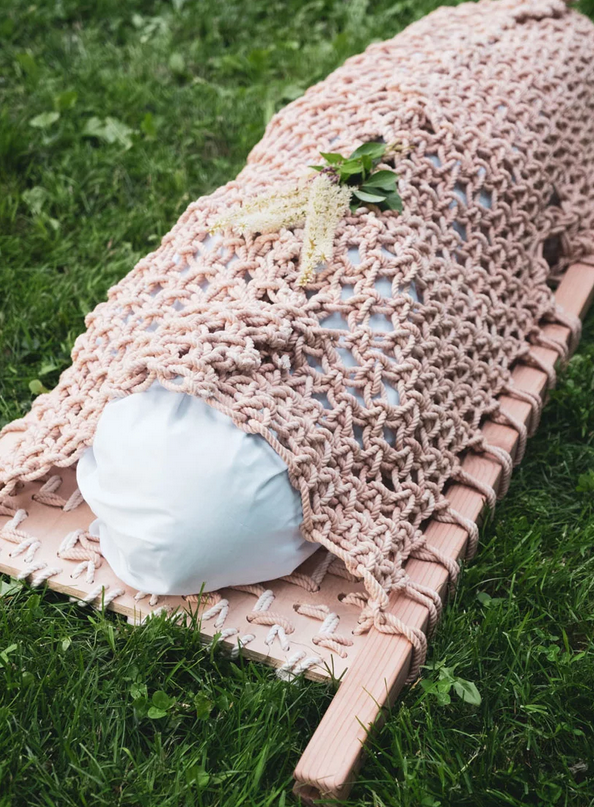
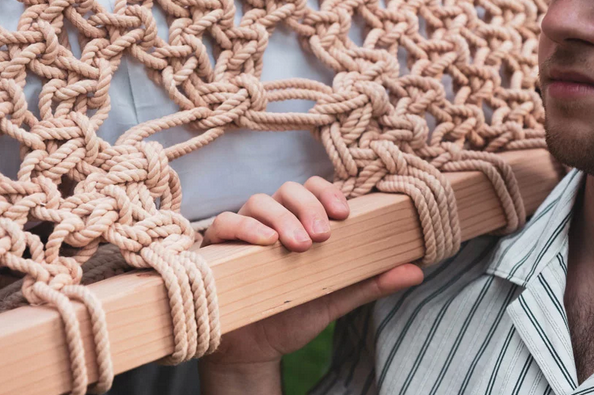
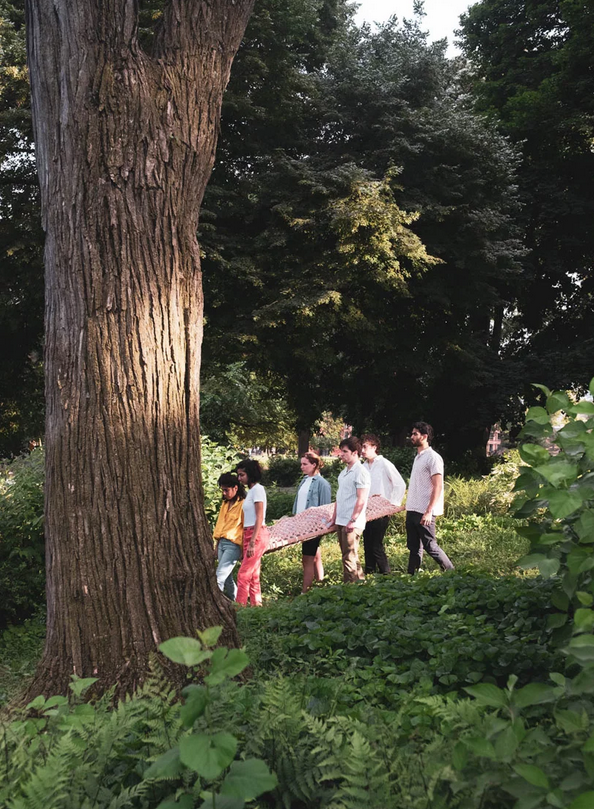
Complete Article ↪HERE↩!
Making dying meaningful with an end of life doula
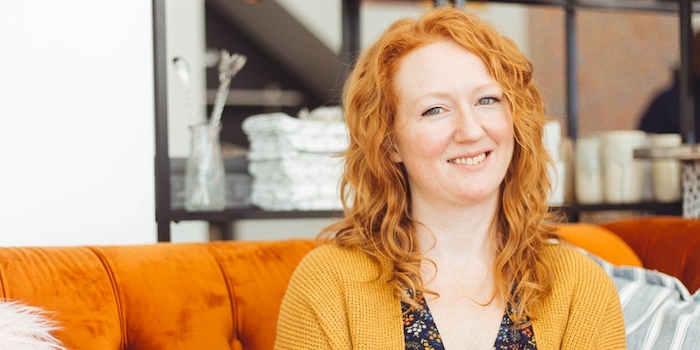
My dad died nine years ago after he suffered a long, debilitating illness. It was an outcome we knew was inevitable when he was diagnosed 10 years prior, but that didn’t make it any less difficult to see him slowly lose all of the functions that are necessary for one to live a fruitful life. At the end, I spend two weeks at his bedside, in his home, alongside my family, and there were times where — despite the visits from the wonderful and dedicated hospice nurses, and despite knowing this was ahead of us — the emotional toll we experienced as we honored his directive to finish his life at home without invasive life saving measures was overwhelming.
I know I’m not alone here. That every day, people are dealing with the overwhelming feelings and decisions that accompany the death of a loved one. It’s something we will all experience at some point in our lives, yet it’s a topic we’d rather avoid, that we’d rather not think about or deal with until we absolutely have to.
A couple of months ago I listened to a podcast that examined our stigmas and stereotypes surrounding death, and I was introduced to the concept of a “death doula.” We are generally familiar with the concept of a doula at birth — someone who is not your doctor or midwife or nurse or partner or family member — but is there to provide physical and emotional support for the mother before, during, and after the birth. A death, or end of life doula, provides physical and emotional support for those who are dying, and their families, throughout the death process. It makes so much sense! Of course this needs to be a thing! And indeed it is, right here in our community. Not long after this initial introduction to the concept, I stumbled across the Instagram profile for Threshold End of Life Doula Services, a relatively new service started by Melanie Sheckels, a local hospice nurse.
Sheckels has been a nurse for almost eight years, many of those years with cardiac patients, and has been present for deaths not only professionally, but more recently in her personal life. Her mother passed away just over a year ago, and her nursing experience gave her insight into how to counsel and advocate for her mother throughout the process. “She and I had many in depth conversations about what quality of life meant to her, and she asked me to advocate for her if she was not able to do so for herself. She had an end stage lung disease, and it was very difficult for her to talk and breathe, so she asked the doctor to just ask me to make decisions for her. Those decisions really supported her comfort and her dignity, and it created a lot of peace and healing for us both. So when I look back at that experience, I can see so many ways that could’ve been a really traumatic experience, and I was able to make it a really good one relative to the situation.”
Not all dying people and their families have the benefit of a close friend or family member with a working knowledge of what the dying process looks like, so Sheckels felt that she could use her experience to provide such a service for those families in our community.
“To be perfectly honest, a lot of my experiences around the dying and their families during the end, professionally, have been rather traumatic. Hospital deaths aren’t often pretty. Obviously we do our best, but it’s a cold sterile environment, it’s unfamiliar, and almost nothing that’s happening is within the control of the person who is doing the dying. It’s hard to maintain comfort let alone anything meaningful, ceremonial. I really noticed that all of these experiences had given me this insight and skill for being able to be present for people in a way that really improved their experience.”
So, what does it look like to be an end of life doula? Sheckels emphasizes that it’s really different for every person, every family, but that it ranges from talking through those practical issues such as advanced directives and what different medical interventions look like, to being sort of a life coach. She tries to help each person identify their priorities, and look to those priorities to determine what quality of life looks like for them. Often people have unrealistic expectations of the medical industry, that their loved one is just one intervention away, when this is often not the case. “There’s this idea that if we can then we should. This idea that death is something that has to be fought off. These things put a lot of pressure on the person that is dying.” Sometimes their experience becomes a “prolonged experience of life as a dying person.”
Sheckels helps the person create a care plan called The Best Last Three Months that addresses the emotional, spiritual, physical, and mental domains of life. “We identify what they really need to feel a sense of completion in that area. If you were to pass tomorrow, what would be the hardest thing for you to let go of? Sometimes those things are not really achievable, so we try to tease out what the significance is of that thing and find a meaningful and realistic way to do it.”
Legacy planning is also a part of the discussion. She helps people work through those big questions: “did I matter, how did I matter, and will the people that I’m leaving behind be okay without me?” For the family, she helps them work through planning vigil during active dying, and how she can help facilitate that. It may mean having a doula present for days, 24 hours at a time. Sheckels works with another end of life doula to help accommodate these more intense situations. She can also be a resource for lessening caregiver burnout by listening and allowing that person to express their emotions or staying with their loved one so they can get out and about.
The concept of an end of life doula has really emerged with the past 10 years, and while there is not yet a certification for the practice, there are various organizations that offer training. Sheckels trained with the Conscious Dying Institute. She explained that many of these organizations are working to develop a certification exam and create an industry standard, and they are also connecting with the National Hospice and Palliative Care Organization to blend their work with hospice work, much like a birth doula works alongside midwives and doctors.
Beyond the personal care of families, it’s clear that Sheckels hopes to educate the community about the dying process. As she states, “A lot of people aren’t ready to approach death in a straightforward manner.” It goes back to fear and avoidance. “We take our fear and denial and put it in a closet and don’t look at it.” Through her work, she hopes to bring that fear and denial out into the open to work through it in an honest way.
I’ve often marveled at those who work with the dying and their grieving families, and I wonder about their well-being — their ability to care for themselves and separate from those intense emotions from time to time. Sheckels eloquently shares her strategy for self-care. “To walk people to and from the gate of mortality, I have to be able to navigate that terrain for myself. I have to regularly undertake personal work to maintain the ability to be present in the moment, to connect deeply with myself and others, and to embrace the impermanence of all living things, up to and including myself. That looks like meditation, journaling, therapy, connecting with nature, and completing my own end of life care planning.”
You can find out more about Threshold End of Life Doula Services through Facebook or Instagram, or reaching out at thresholddoula@gmail.com.
Complete Article ↪HERE↩!
Listening To Older Patients Who Want To Stop Dialysis

Dr. Susan Wong sat down with an 84-year-old patient in the hospital, where he’d been admitted with a flare-up of a serious autoimmune condition and deteriorating kidney function.
The older man told her he wanted to go home; he’d had a good life and was ready for its end. He didn’t want aggressive care — including dialysis — having witnessed his wife and son die painfully in intensive care years ago.
Wong, an assistant professor of nephrology at the University of Washington, was prepared to follow the man’s wishes, but other physicians, eager to pursue tests and treatments, disagreed. For a week, the doctors argued about what to do. Finally, they discharged the patient, who died in hospice care a few weeks later.
Older adults with advanced kidney disease who want to forgo dialysis often encounter similar resistance from physicians, according to a new study in JAMA Internal Medicine by Wong and colleagues at the Veterans Affairs Puget Sound Health Care System in Seattle, where she’s an investigator.
The researchers documented doctors’ reactions by reviewing medical charts of 851 older patients with chronic kidney disease who refused dialysis at the VA health system from 2000 to 2011. In their notes, physicians frequently speculated the patients were incompetent, depressed, suicidal or irrational.
With dialysis, people are hooked up to a machine that removes waste from their blood, usually three times a week for four hours at a stretch. Many older adults find the treatments burdensome, and medical complications are common.
Yet patients who expressed reservations about this treatment were sometimes labeled as difficult or unprepared to confront the reality of their medical condition. “Still in denial about his kidney disease and his need for hemodialysis in the near future — repeat discussions with patient and wife regarding compliance,” one nephrologist wrote. Even when patients were firm about declining dialysis, doctors repeatedly questioned their decisions.
“Clinical practice guidelines for advanced kidney disease are geared toward survival, not what would give patients the best quality of life or the greatest functional capacity,” Wong said. Another factor at play: Nephrologists aren’t trained to ask seriously ill patients what’s most important to them and shape treatment recommendations accordingly. Although most patients want to have such conversations with a kidney specialist, few do so, studies have found.
“We don’t really know how to help patients with serious illness make decisions that are right for them or what to do when they don’t really want dialysis,” said Dr. Jane Schell, an assistant professor of palliative care and nephrology at the University of Pittsburgh.
Conversations about the potential benefits and burdens of dialysis, as well as alternatives, are especially important for frail patients 75 and older who have two or more chronic conditions, such as diabetes and high blood pressure, and difficulty with daily activities such as bathing or walking — a group at risk of experiencing significant complications from dialysis but not achieving longer life.
Healthier older adults have better outcomes on dialysis — a valuable treatment for many people. “We shouldn’t limit access to dialysis based on age, but we should have meaningful conversations about goals of care and make it clear that dialysis is a choice and that patients have alternatives,” said Dr. Bjorg Thorsteinsdottir, an assistant professor of internal medicine and bioethics at the Mayo Clinic.
Options that should be discussed include comprehensive conservative care, which calls for preserving as much kidney function as possible, managing a patient’s health problems, dealing with symptoms such as nausea, swelling, itchiness, pain and breathing difficulties, and preparing for end-of-life care; peritoneal dialysis or hemodialysis at home; and palliative dialysis, a less intensive version of this treatment that keeps people alive for longer but isn’t meant to restore kidney function.
Comprehensive conservative care programs are few and far between (in New York City, Pittsburgh, Seattle, San Francisco and a few other locations), but efforts are underway to change that. With funding from the American Society of Nephrology, Schell and colleagues at the University of Pittsburgh have developed an online conservative care curriculum set to debut in March. Nineteen nephrology training programs for physicians are set to participate.
Also, the Pathways Project, funded by the Gordon and Betty Moore Foundation, is working to make palliative care (also known as supportive care) for patients with advanced kidney disease widely available. (KHN’s coverage of end-of-life and serious illness issues is also supported in part by the Gordon and Betty Moore Foundation.) Dr. Alvin Moss, co-investigator of the project and professor of medicine at West Virginia University School of Medicine, said the project hopes to sign up 10-15 dialysis centers this year.
Sometimes, patients choose a time-limited trial of dialysis with the understanding that they can change their minds down the road.
Cyndy Patton’s 86-year-old mother, Isabel, learned last spring she had advanced kidney disease after going to a Pittsburgh hospital, sickened by repeated bouts of vomiting. Physicians suggested she try dialysis for a few weeks and see if her kidneys might rejuvenate. (The older woman had survived open-heart surgery and a stroke and was living on her own after her husband’s death.)
After a week in the hospital and another week in a rehabilitation center, there was no change: Patton’s mother still needed dialysis. Five weeks later, she confessed to her daughter that the treatment was making her miserable. But giving it up felt like committing suicide, she told Patton — an unacceptable option.
A week later, Isabel had changed her mind. “This is not a life I care to lead, being hooked up to these machines,” she told Patton. “What am I doing this for?” The older woman had consulted with Schell at the University of Pittsburgh about palliative care and hospice care, and she chose hospice.
Dialysis ended and the family gathered at Isabel’s bedside. “She was all ready to die — but she didn’t, and is still living to this day,” Patton said.
It’s an example of how hard it can be to predict what will happen to any given patient with advanced kidney disease. What’s important for the patient to understand is that “it’s not always all or nothing — dialysis or death,” Thorsteinsdottir said.
“Patients have to be very assertive and tell their medical team: This is what I want and what I don’t want,” Moss said. For more information, he suggested people explore the websites of the Coalition for Supportive Care of Kidney Patients (he chairs that organization), the National Kidney Foundation and the American Association of Kidney Patients, and “really spend some time learning about your options.”
Complete Article ↪HERE↩!
